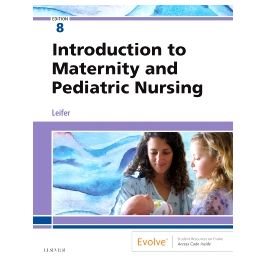This is completed downloadable of Test Bank for Introduction to Maternity and Pediatric Nursing 8th Edition by Leifer

Product Details:
- ISBN-10 : 0323483976
- ISBN-13 : 978-0275971281
- Author: Gloria Leifer
Get a solid foundation in maternity and pediatric nursing! Written in a clear, concise, friendly style, Introduction to Maternity and Pediatric Nursing, 8th Edition is the complete guide to caring for maternity and pediatric patients. This best-selling text is organized by developmental stages, discussions of pediatric disorders by body system from simple-to-complex and health-to-illness, and includes a focus on family health. This edition also contains newly updated NCLEX® style review questions, new case studies, new content on zika virus, QSEN and safety, and expanded phases of pregnancy.
Table of Content:
- Unit I: An Overview of Maternity and Pediatric Nursing
- 1: The Past, Present, and Future
- The past
- The present
- The future
- Unit II: Maternal–Newborn Nursing and Women’s Health
- 2: Human Reproductive Anatomy and Physiology
- Puberty
- Reproductive systems
- The human sexual response
- 3: Fetal Development
- Cell division and gametogenesis
- Fertilization
- Development
- Accessory structures of pregnancy
- Fetal circulation
- Impaired prenatal development and subsequent illness
- Multifetal pregnancy
- 4: Prenatal Care and Adaptations to Pregnancy
- Goals of prenatal care
- Preconception care
- Prenatal visits
- Definition of terms
- Determining the estimated date of delivery
- Diagnosis of pregnancy
- Physiological changes in pregnancy
- Nutrition for pregnancy and lactation
- Exercise during pregnancy
- Smoking during pregnancy
- Travel during pregnancy
- Common discomforts in pregnancy
- Psychosocial adaptation to pregnancy
- Prenatal education
- Effect of pregnancy and lactation on medication metabolism
- Immunizations during pregnancy
- Nursing care during pregnancy
- 5: Nursing Care of Women With Complications During Pregnancy
- Assessment of fetal health
- Pregnancy-related complications
- Pregnancy complicated by medical conditions
- Environmental hazards during pregnancy
- Effects of a high-risk pregnancy on the family
- 6: Nursing Care of Mother and Infant During Labor and Birth
- Cultural influence on birth practices
- Settings for childbirth
- Components of the birth process
- Normal childbirth
- Admission to the hospital or birth center
- Nursing care of the woman in false labor
- Nursing care before birth
- Stages and phases of labor
- Vaginal birth after cesarean
- Nursing care during birth
- Nursing care immediately after birth
- Cord blood banking
- Microbiomes and nursing care during labor and delivery
- 7: Nursing Management of Pain During Labor and Birth
- Education for childbearing
- Childbirth and pain
- 8: Nursing Care of Women With Complications During Labor and Birth
- Obstetric procedures
- Abnormal labor
- Premature rupture of membranes
- Preterm labor
- Prolonged pregnancy
- Emergencies during childbirth
- 9: The Family After Birth
- Adapting nursing care for specific groups and cultures
- Cultural influences on postpartum care
- Postpartum changes in the mother
- Emotional care
- Parenthood
- The family care plan
- 10: Nursing Care of Women with Complications After Birth
- Shock
- Hemorrhage
- Thromboembolic disorders
- Infections
- Mood disorders
- The homeless mother and newborn
- 11: The Nurse’s Role in Women’s Health Care
- Goals of healthy people 2030
- Preventive health care for women
- Menstrual disorders
- The normal vagina
- Gynecological infections
- Family planning
- Menopause
- 12: The Term Newborn
- Adjustment to extrauterine life
- Phase 3: care of the newborn
- 13: Preterm and Postterm Newborns
- The preterm newborn
- The postterm newborn
- Transporting the high-risk newborn
- Discharge of the high-risk (preterm birth) newborn
- 14: The Newborn with a Perinatal Injury or Congenital Malformation
- Malformations present at birth
- Metabolic defects
- Chromosomal abnormalities
- Perinatal injuries
- Infant of a diabetic mother
- Unit III: The Growing Child and Family
- 15: An Overview of Growth, Development, and Nutrition
- Growth and development
- Nutrition
- Play
- Traveling with children
- Ongoing heath supervision
- 16: The Infant
- General characteristics
- Development and care
- Community-based care: a multidisciplinary team
- Illness prevention
- Infant safety
- Summary of major developmental changes in the first year
- 17: The Toddler
- General characteristics
- Guidance and discipline
- Daily care
- Toilet independence
- Nutrition counseling
- Day care
- Injury prevention
- Toys and play
- 18: The Preschool Child
- General characteristics
- Physical, mental, emotional, and social development
- Guidance
- Preschool
- Daily care
- Accident prevention
- Play during health and illness
- Nursing implications of preschool growth and development
- 19: The School-Age Child
- General characteristics
- Physical growth
- Sexual development
- Influences from the wider world
- Play
- Latchkey children
- Physical, mental, emotional, and social development
- Guidance and health supervision
- 20: The Adolescent
- General characteristics
- Growth and development
- Parenting the adolescent
- Health promotion and guidance
- Common problems of adolescence
- The nursing approach to adolescents
- Unit IV: Adapting Care To The Pediatric Patient
- 21: The Child’s Experience of Hospitalization
- Health care delivery settings
- The child’s reaction to hospitalization
- The parents’ reactions to the child’s hospitalization
- The nurse’s role in the child’s hospitalization
- Home care
- 22: Health Care Adaptations for the Child and Family
- Admission to the pediatric unit
- Data collection, observation, and recording
- Physiological responses to medications in infants and children
- Nursing responsibilities in administering medications to infants and children
- Selected procedures and their adaptation to children
- Unit V: The Child Needing Nursing Care
- 23: The Child With a Sensory or Neurological Condition
- The ears
- The eyes
- The nervous system
- 24: The Child with a Musculoskeletal Condition
- Musculoskeletal system
- Musculoskeletal system: differences between the child and the adult
- Observation and assessment of the musculoskeletal system in the growing child
- Pediatric trauma
- Disorders and dysfunction of the musculoskeletal system
- Family violence
- Child abuse
- 25: The Child With a Respiratory Disorder
- The respiratory system
- 26: The Child with a Cardiovascular Disorder
- The cardiovascular system
- 27: The Child With a Condition of the Blood, Blood-Forming Organs, or Lymphatic System
- Hematological system
- Anemias
- Bleeding disorders
- Disorders of white blood cells
- Nursing care of the chronically ill child
- Nursing care of the dying child
- 28: The Child With a Gastrointestinal Condition
- The gastrointestinal tract
- Disorders and dysfunction of the gastrointestinal tract
- 29: The Child With a Genitourinary Condition
- Development of the urinary tract
- Development of the reproductive systems
- Assessment of urinary function
- Impact of urinary or genital surgery on growth and development
- 30: The Child With a Skin Condition
- Skin development and functions
- Skin disorders and variations
- Nursing care of the burned child
- Sunburn
- Sunscreens
- Frostbite
- 31: The Child With a Metabolic Condition
- Integration of the nervous and endocrine systems
- Disorders and dysfunction of the endocrine system
- Endocrine disorders
- 32: Childhood Communicable Diseases, Bioterrorism, Natural Disasters, and the Maternal-Child Patient
- Introduction
- Common childhood communicable diseases
- Review of terms
- Host resistance
- Medical asepsis, standard precautions, and transmission-based precautions
- Rashes
- Worldwide immunization programs
- The future of immunotherapy
- Bioterrorism and the maternal-child patient
- Sexually transmitted infections
- 33: The Child With an Emotional or Behavioral Condition
- The nurse’s role
- Types and settings of treatment
- Childhood Mental Disorders
- Organic Behavioral Disorders
- Environmental or biochemical behavioral disorders
- Minimizing the impact of behavioral disorders in children
- Unit VI: The Changing Health Care Environment
- 34: Complementary and Alternative Therapies in Maternity and Pediatric Nursing
- Complementary and alternative therapies
- Appendix A: Standard Precautions and Transmission-Based Isolation Precautions
- Appendix B: Sequence for Donning and Removing Personal Protective Equipment (PPE)
- Appendix C: The Joint Commission’s List of Dangerous Abbreviations, Acronyms, and Symbols
- Appendix D: Commonly Used Abbreviations in Maternity and Pediatric Nursing
- Appendix E: Common Spanish Phrases Used in Maternity and Pediatric Nursing
- Appendix F: Multilingual Glossary of Symptoms
- Appendix G: Conversion of Pounds and Ounces to Grams for Newborn Weights
- Appendix H: Normal Vital Signs and Temperature Equivalents for Infants and Children
- Appendix I: Pediatric Laboratory Values Reference
- Appendix J: Blood Pressure (BP) Levels for Boys and Girls by Age and Height Percentile
- Master Citations
- Glossary
- Index





